Three-Jet Powder Flow and Laser–Powder Interaction in Laser Melting Deposition: Modelling Versus Experimental Correlations
Abstract
1. Introduction
2. Mathematical Modelling
2.1. Powder Stream Distribution in the LMD Process
- The gravitational effect, during the powder particle flow, is neglected. This assumption is reasonable as the time of flight of powder particles across the laser beam interaction zone is very short, equivalent to 25% of standoff distance [19].
- All the powder particles are spherical. Moreover, their normalized size distribution is considered in the modelling.
- There are two types of collisions mainly involved in the LMD process: (i) Powder debits with the powder feeder’s walls and (ii) among the powder particles. If such collisions are taken into account, various factors, including elastic motion, damping effects, friction forces due to sliding effects, powder particles’ velocity, reiterated powder flow rate, and powder debits overlapping, must be considered. It will result in a tremendous number of unknown variables and a complex system of equations, which requires a considerable amount of calculation time, iteratively. Besides, the powder debits are microparticles. It means that one should carry out investigations at the microscale to monitor the quantities mentioned above. It will result in a tedious and challenging system of equations. Moreover, there are studies [20,21,22] that show that if such collisions are ignored, the resultant flow rate will make a difference within the range of no more than 9–12%. Based on the above findings and to develop a simplified dynamic system, it is reasonable to ignore the collision between powder particles. Hence, the overlapping and all sort of collisions have been ignored throughout the deposition process.
2.2. Temperature Distribution within the Substrate in the LMD Process after Powder Addition
2.2.1. Powder Particles Heating: Inflight and within Melt-Pool
2.2.2. Powder Particles’ within Melt-Pool Heating
3. Materials and Methods
3.1. Analytical Computations
3.2. Experimentation
4. Results and Discussion
5. Conclusions
Author Contributions
Funding
Acknowledgments
Conflicts of Interest
List of Symbols
| : | Area of powder particle |
| : | Laser beam area |
| cpp: | Powder particle’s specific heat |
| cps: | Substrate’s specific heat |
| dl: | Distance between the center of the laser beam and powder nozzle |
| : | Thermal gas diffusivity |
| Lfp: | Powder particle’s latent heat of fusion |
| Lfs: | Substrate’s latent heat of fusion |
| : | Powder particles’ flow rate |
| : | Normal distribution of powder debits |
| Nu: | Nusselt number |
| : | Gaussian powder flow |
| Pr: | Peclét number |
| rs: | Radius of powder nozzle |
| : | Radius of the mean powder particle |
| Tpboil: | Powder particle’s boiling temperature |
| Tpm: | Powder particle’s melting temperature |
| Tpsol: | Powder particle’s solidus temperature |
| tiph: | Laser–powder particles interaction time needed to initiate the vaporization |
| Tsboil: | Substrate’s boiling temperature |
| Tsm: | Substrate’s melting temperature |
| Tssol: | Substrate’s solidus temperature |
| Tsli: | Laser–substrate interaction time needed to initiate the vaporization |
| : | Ambient temperature |
| : | The volumetric flow rate of gases |
| : | The velocity of powder particles |
| : | The laser scanning speed |
| : | The velocity of gas |
| : | Powder particles’ density |
| : | Density of gas |
| : | Viscosity of gas |
| : | Laser beam attenuation ratio |
| : | Powder efficiency |
| : | Powder particles’ cloud density |
| : | Substrate’s thermal diffusivity |
| : | Substrate’s laser absorptivity |
References
- Mahmood, M.A.; Popescu, A.C.; Mihailescu, I.N. Metal Matrix Composites Synthesized by Laser-Melting Deposition: A Review. Materials 2020, 13, 2593. [Google Scholar] [CrossRef] [PubMed]
- Pellizzari, M.; Jam, A.; Tschon, M.; Fini, M.; Lora, C.; Benedetti, M. A 3D-Printed Ultra-Low Young’s Modulus β-Ti Alloy for Biomedical Applications. Mater 2020, 13, 2792. [Google Scholar] [CrossRef] [PubMed]
- Zhong, C.; Pirch, N.; Gasser, A.; Poprawe, R.; Schleifenbaum, J.H. The influence of the powder stream on high-deposition-rate laser metal deposition with inconel 718. Metals 2017, 7, 443. [Google Scholar] [CrossRef]
- Chioibasu, D.; Achim, A.; Popescu, C.; Stan, G.; Pasuk, I.; Enculescu, M.; Iosub, S.; Duta, L.; Popescu, A. Prototype Orthopedic Bone Plates 3D Printed by Laser Melting Deposition. Materials 2019, 12, 906. [Google Scholar] [CrossRef] [PubMed]
- Bucă, A.M.; Oane, M.; Mahmood, M.A.; Mihăilescu, I.N.; Popescu, A.C.; Sava, B.A.; Ristoscu, C. Non-fourier estimate of electron temperature in case of femtosecond laser pulses interaction with metals. Metals 2020, 10, 606. [Google Scholar] [CrossRef]
- Yang, N. Concentration model based on movement model of powder flow in coaxial laser cladding. Opt. Laser Technol. 2009, 41, 94–98. [Google Scholar] [CrossRef]
- Lin, J. Concentration mode of the powder stream in coaxial laser cladding. Opt. Laser Technol. 1999, 31, 251–257. [Google Scholar] [CrossRef]
- Lin, J. Numerical simulation of the focused powder streams in coaxial laser cladding. J. Mater. Process. Technol. 2000, 105, 17–23. [Google Scholar] [CrossRef]
- Pan, H.; Liou, F. Numerical simulation of metallic powder flow in a coaxial nozzle for the laser aided deposition process. J. Mater. Process. Technol. 2005, 168, 230–244. [Google Scholar] [CrossRef]
- Pan, H.; Sparks, T.; Thakar, Y.D.; Liou, F. The investigation of gravity-driven metal powder flow in coaxial nozzle for laser-aided direct metal deposition process. J. Manuf. Sci. Eng. Trans. ASME 2006, 128, 541–553. [Google Scholar] [CrossRef]
- Pinkerton, A.; Pinkerton, A.J.; Li, L. A verified model of the behaviour of the axial powder stream concentration from a coaxial laser cladding nozzle. Laser Inst. Am. 2002, 2002, 165528. [Google Scholar] [CrossRef]
- Pinkerton, A.J.; Lin, L. Modelling powder concentration distribution from a coaxial deposition nozzle for laser-based rapid tooling. J. Manuf. Sci. Eng. Trans. ASME 2004, 126, 33–41. [Google Scholar] [CrossRef]
- Kizaki, Y.; Azuma, H.; Yamazaki, S.; Sugimoto, H.; Takagi, S. Phenomenological studies in laser cladding Part I: Time-resolved measurements of the absorptivity of metal powder. Jpn. J. Appl. Phys. 1993, 32, 205–212. [Google Scholar] [CrossRef]
- Liu, J.; Li, L. Effects of powder concentration distribution on fabrication of thin-wall parts in coaxial laser cladding. Opt. Laser Technol. 2005, 37, 287–292. [Google Scholar] [CrossRef]
- Tabernero, I.; Lamikiz, A.; Ukar, E.; López De Lacalle, L.N.; Angulo, C.; Urbikain, G. Numerical simulation and experimental validation of powder flux distribution in coaxial laser cladding. J. Mater. Process. Technol. 2010, 210, 2125–2134. [Google Scholar] [CrossRef]
- Galarraga, H.; Warren, R.J.; Lados, D.A.; Dehoff, R.R.; Kirka, M.M.; Nandwana, P. Effects of heat treatments on microstructure and properties of Ti-6Al-4V ELI alloy fabricated by electron beam melting (EBM). Mater. Sci. Eng. A 2017, 685, 417–428. [Google Scholar] [CrossRef]
- Toyserkani, E.; Khajepour, A.; Corbin, S. 3-D finite element modeling of laser cladding by powder injection: Effects of laser pulse shaping on the process. Opt. Lasers Eng. 2004, 41, 849–867. [Google Scholar] [CrossRef]
- Cao, X.; Ayalew, B. Control-oriented MIMO modeling of laser-aided powder deposition processes. In Proceedings of the American Control Conference, Chicago, IL, USA, 1–3 July 2015; Institute of Electrical and Electronics Engineers Inc.: Piscataway, NJ, USA, 2015; pp. 3637–3642. [Google Scholar]
- Huang, Y.-L.; Liu, J.; Ma, N.-H.; Li, J.-G. Three-dimensional analytical model on laser-powder interaction during laser cladding. J. Laser Appl. 2006, 15, 42. [Google Scholar] [CrossRef]
- Crowe, C.T.; Schwarzkopf, J.D.; Sommerfeld, M.; Tsuji, Y. Multiphase Flows with Droplets and Particles, 2nd ed.; CRC Press, Taylor & Francis Group: Boca Raton, FL, USA, 2012; ISBN 978-1-4398-4051-1. [Google Scholar]
- Liu, C.Y.; Lin, J. Thermal processes of a powder particle in coaxial laser cladding. Opt. Laser Technol. 2003, 35, 81–86. [Google Scholar] [CrossRef]
- Volpp, J.; Prasad, H.S.; Kaplan, A. Behavior of heated powder particles on solid surfaces. Procedia Manuf. 2018, 25, 365–374. [Google Scholar] [CrossRef]
- Forbes, C.; Evans, M.; Hastings, N.; Peacock, B. Normal (Gaussian) Distribution. In Statistical Distributions; John Wiley & Sons, Inc.: Hoboken, NJ, USA, 2010; pp. 143–148. [Google Scholar]
- De Kruif, C.G.; Huppertz, T.; Urban, V.S.; Petukhov, A.V. Casein micelles and their internal structure. Adv. Colloid Interface Sci. 2012, 171, 36–52. [Google Scholar] [CrossRef] [PubMed]
- Toyserkani, E.; Khajepour, A.; Corbin, S. Laser Cladding; CRC Press, Taylor & Francis Group: Boca Raton, FL, USA, 2017; ISBN 0849321727. [Google Scholar]
- Carslaw, H.; Jaeger, J. Conduction of Heat in Solids; Oxford University Press: Oxford, UK, 1959. [Google Scholar]
- Yan, J.; Battiato, I.; Fadel, G.M. A Mathematical Model-Based Optimization Method for Direct Metal Deposition of Multimaterials. J. Manuf. Sci. Eng. 2017, 139. [Google Scholar] [CrossRef]
- Vetter, P.A.; Fontaine, J.; Engel, T.; Lagrange, L.; Marchione, T. Characterization Of Laser-materialInteraction During Laser Cladding Process. WIT Trans. Eng. Sci. 1970, 2. [Google Scholar] [CrossRef]
- Antipas, G.S.E. Experimental and first principles assessment of plasma attenuation during laser treatment of an Al alloy. Trans. Inst. Met. Finish. 2015, 93, 53–56. [Google Scholar] [CrossRef]
- Luo, Y.; Tang, X.; Lu, F.; Chen, Q.; Cui, H. Spatial distribution characteristics of plasma plume on attenuation of laser radiation under subatmospheric pressure. Appl. Opt. 2015, 54, 1090–1096. [Google Scholar] [CrossRef]
- ASM Material Data Sheet. Available online: http://asm.matweb.com/search/SpecificMaterial.asp?bassnum=MTP641 (accessed on 23 February 2020).
- Mirkoohi, E.; Ning, J.; Bocchini, P.; Fergani, O.; Chiang, K.-N.; Liang, S. Thermal Modeling of Temperature Distribution in Metal Additive Manufacturing Considering Effects of Build Layers, Latent Heat, and Temperature-Sensitivity of Material Properties. J. Manuf. Mater. Process. 2018, 2, 63. [Google Scholar] [CrossRef]
- Guo, Y.; Hu, S.; Dong, D.; Wang, W.; Zhang, D. Numerical simulation in the laser energy absorption behavior of Ti6Al4V powder materials during SLM. In Advanced Laser Processing and Manufacturing II; Liu, J., Hong, M., Xiao, R., Eds.; SPIE: Bellingham, WA, USA, 2018; Volume 10813, p. 37. [Google Scholar]
- Emamian, A.; Alimardani, M.; Khajepour, A. Correlation between temperature distribution and in situ formed microstructure of Fe-TiC deposited on carbon steel using laser cladding. Appl. Surf. Sci. 2012, 258, 9025–9031. [Google Scholar] [CrossRef]
- Duan, C.; Zhou, J.; Luo, X.; Zhao, M. Numerical Simulation of Temperature Field of 12crni2 by Laser Melting Deposition. Conf. Ser. Mater. Sci. Eng. 2019, 667. [Google Scholar] [CrossRef]
- Peyre, P.; Dal, M.; Ebastien Pouzet, S.; Castelnau, O.; Ebastien Pouzet, S. Simplified numerical model for the laser metal deposition additive manufacturing process. J. Laser Appl. 2017, 29, 1–8. [Google Scholar]
- Liu, Z.; Zhang, H.C.; Peng, S.; Kim, H.; Du, D.; Cong, W. Analytical modeling and experimental validation of powder stream distribution during direct energy deposition. Addit. Manuf. 2019, 30, 100848. [Google Scholar] [CrossRef]

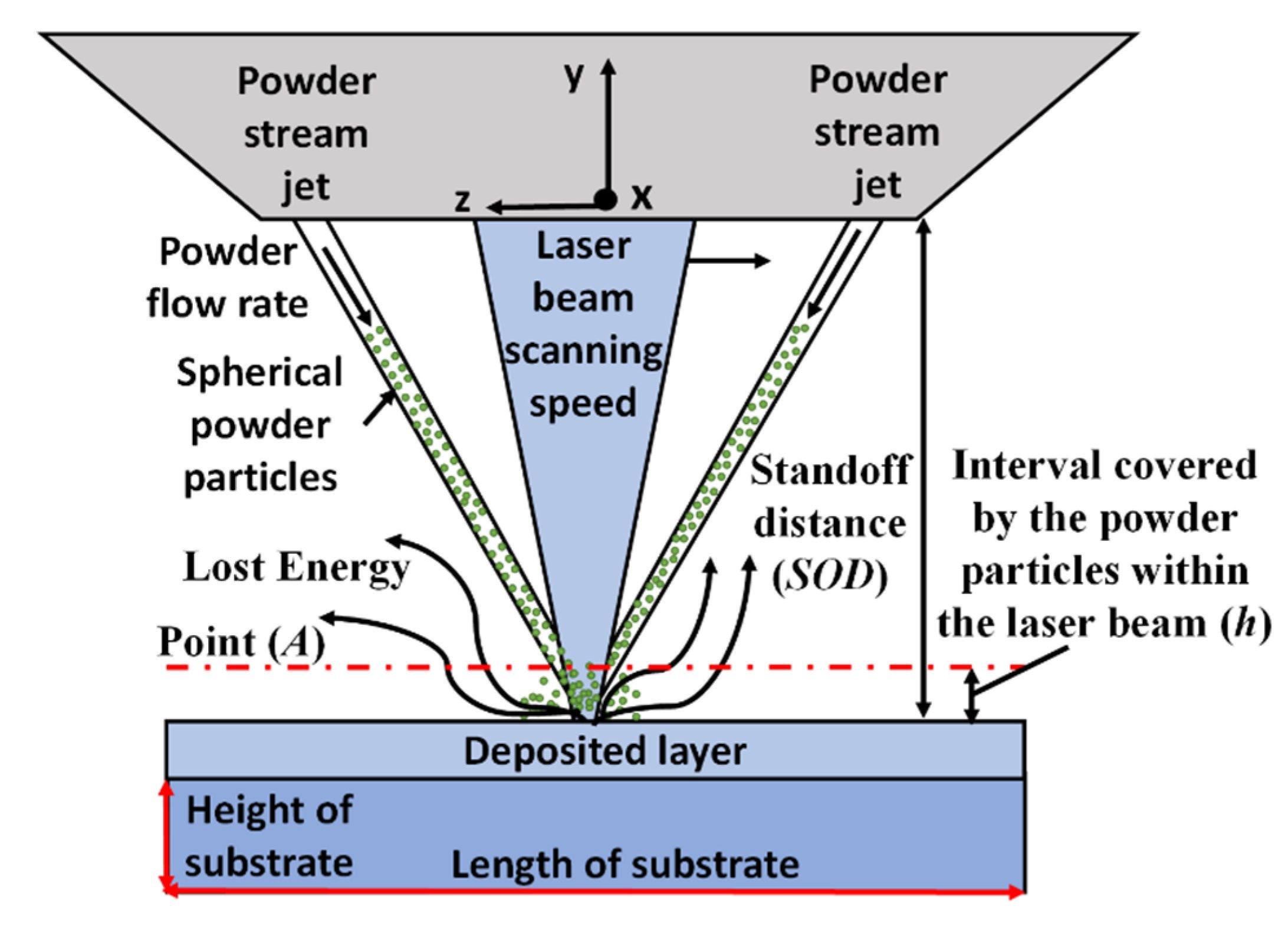
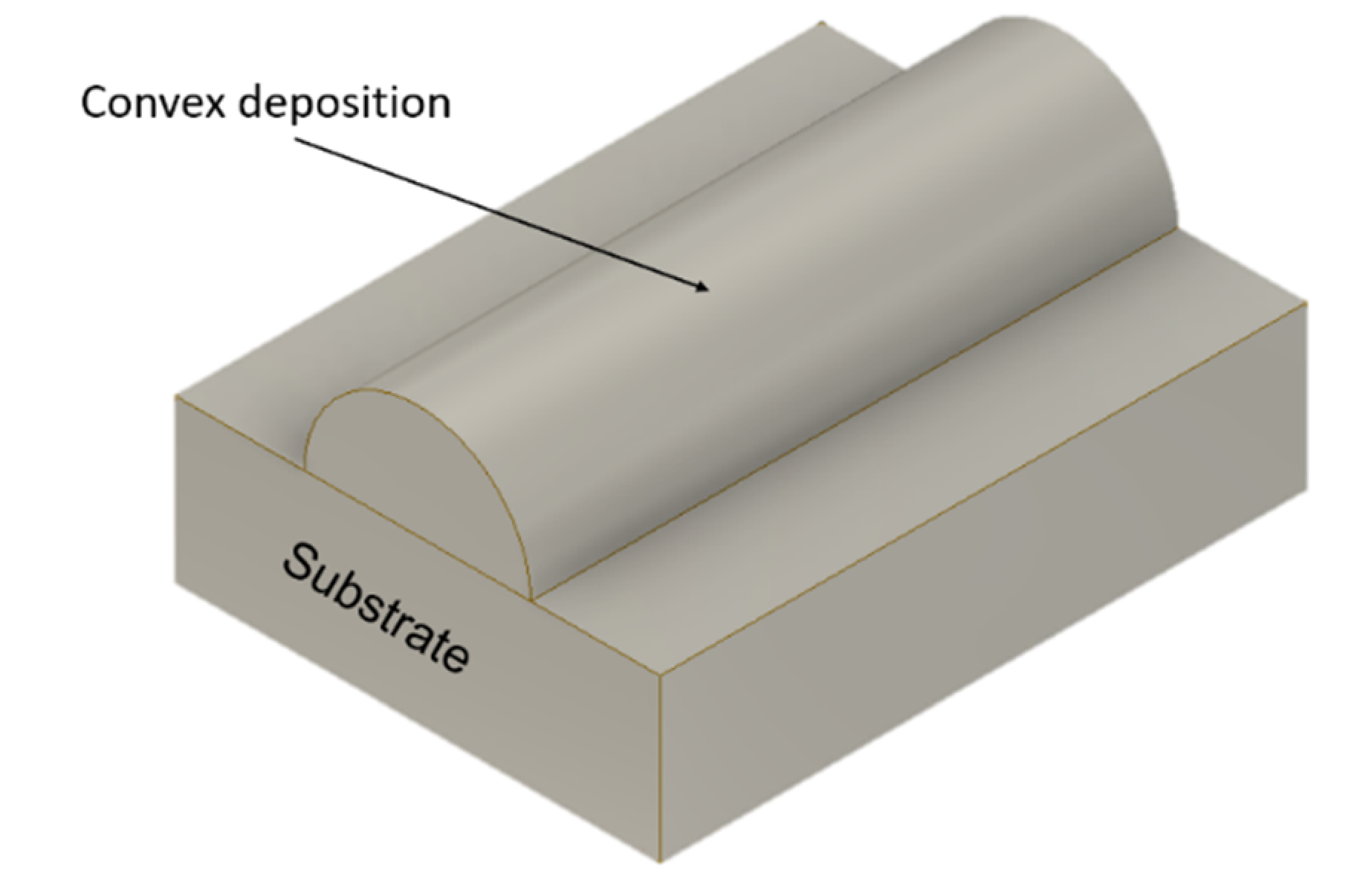
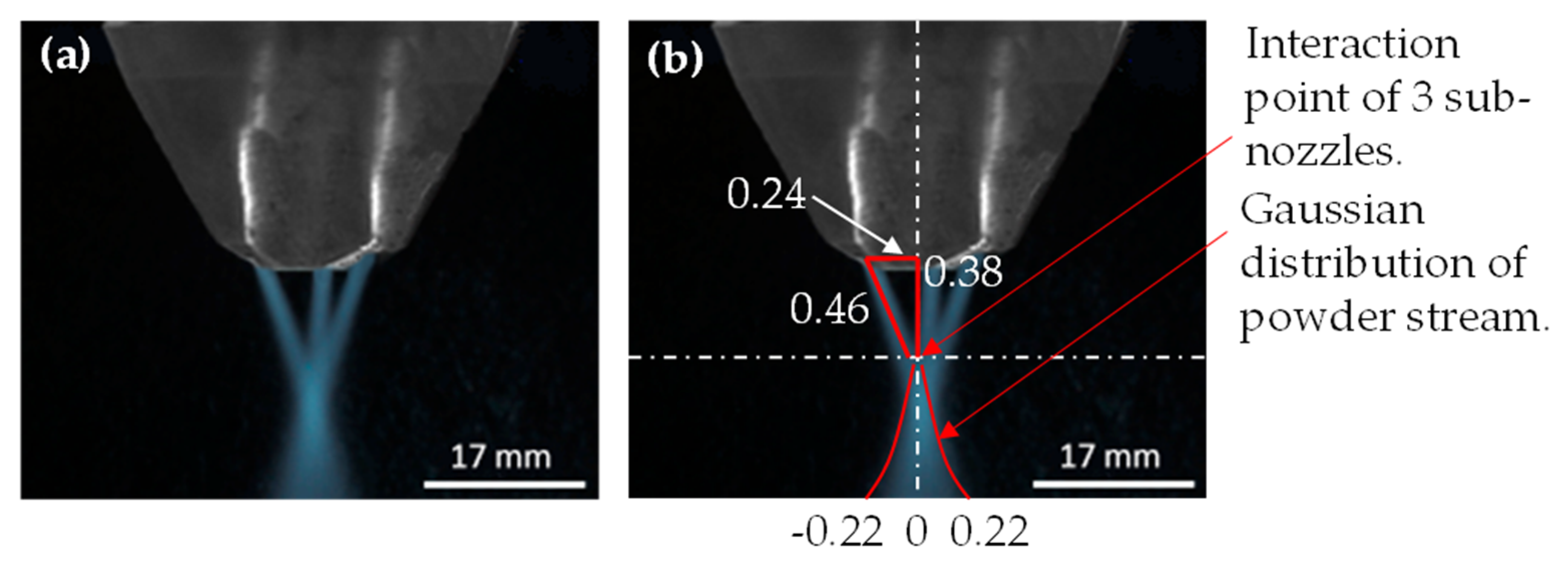



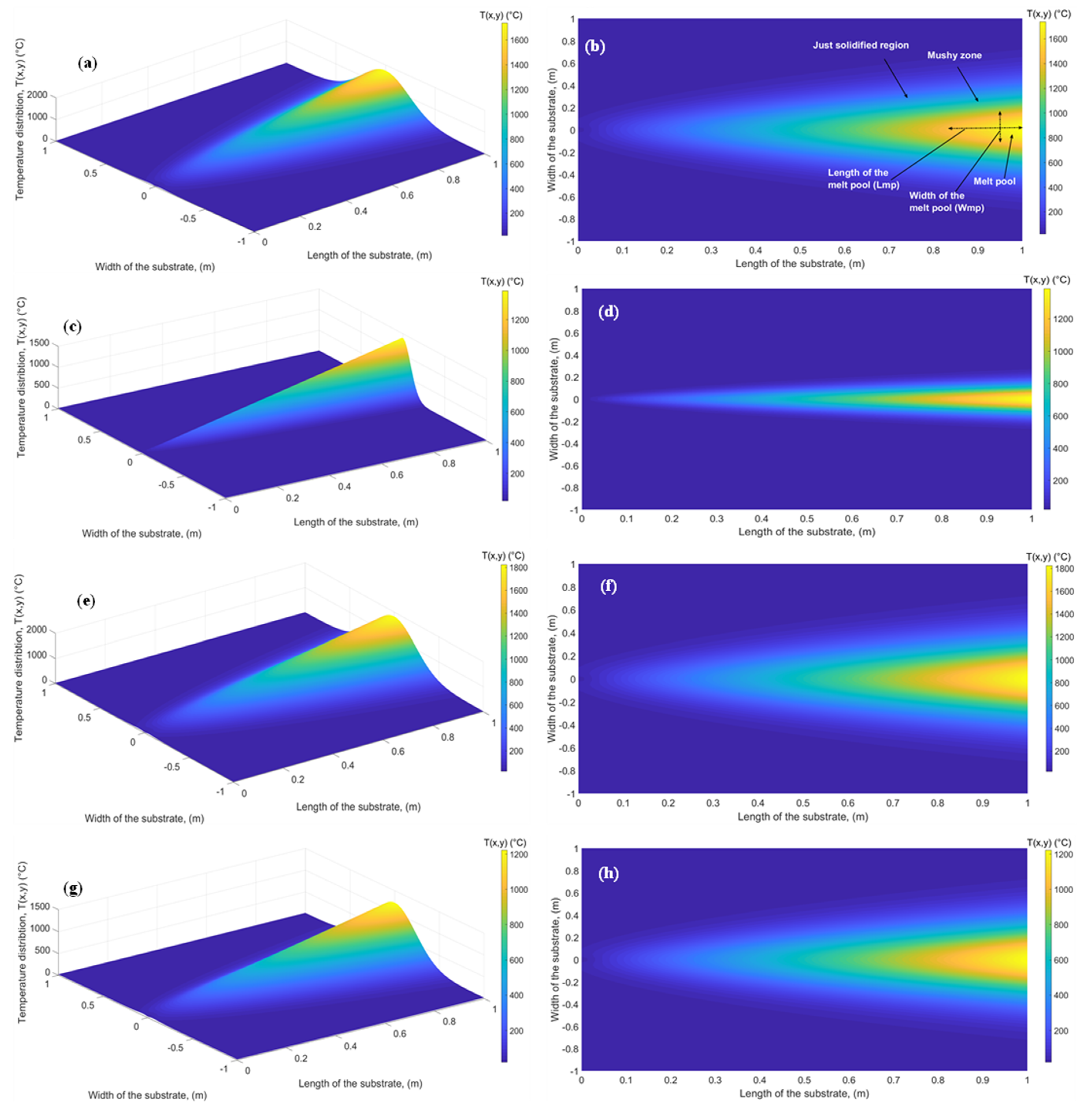

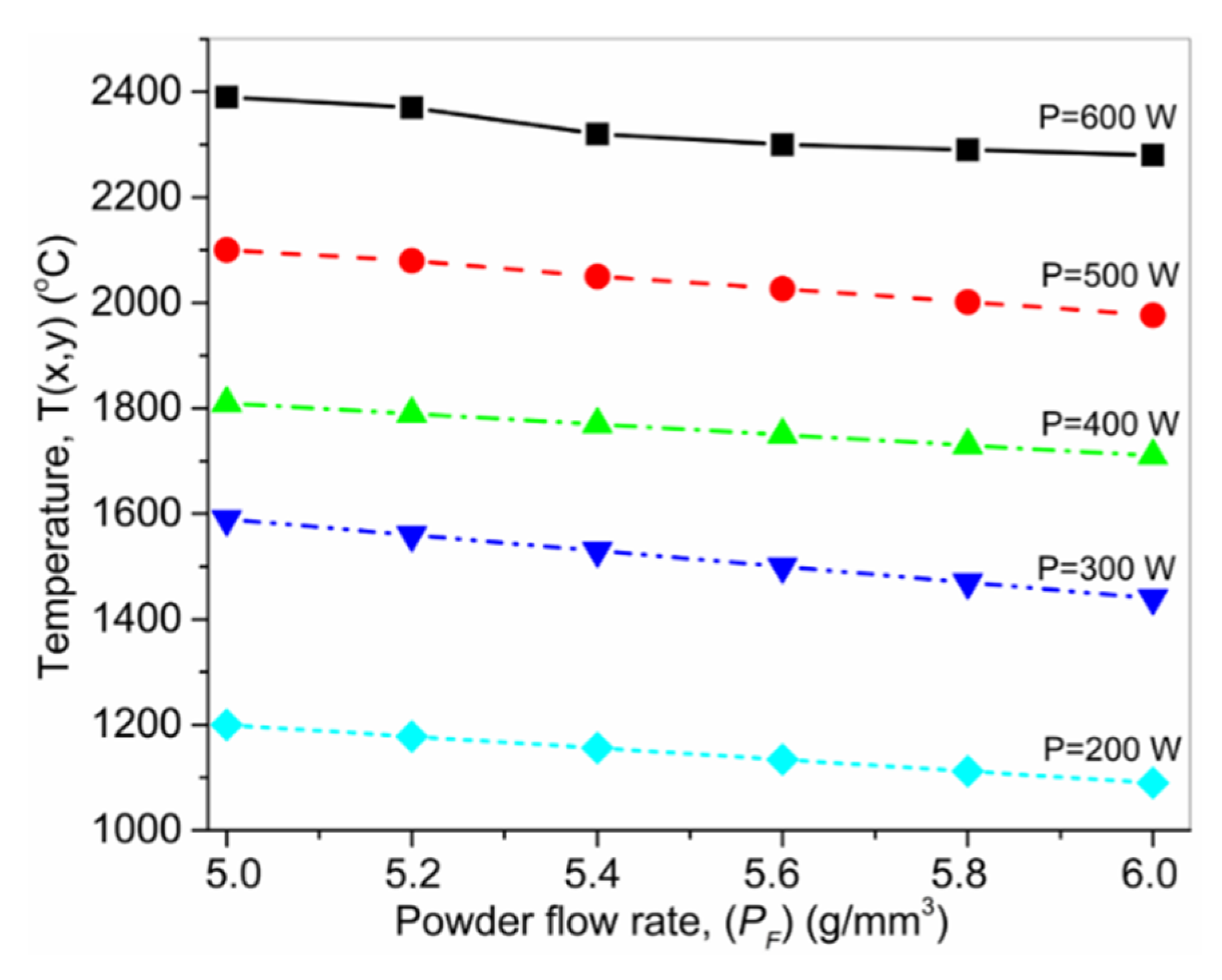
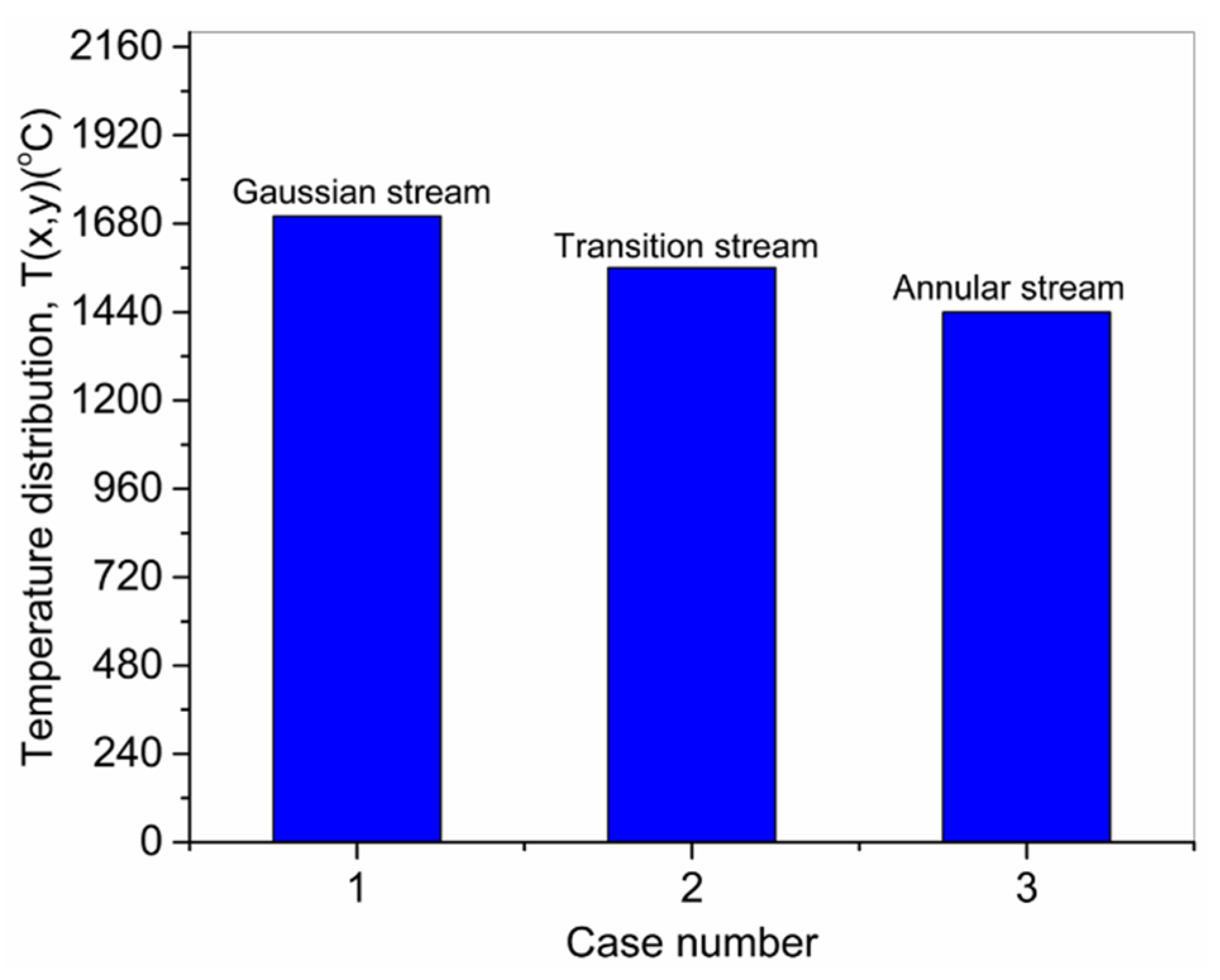
| Parameter Name | Value (Units) |
| Thermal coefficient for radiation | 5.67 × 10−8 (W/m2. °C4) |
| Heat transfer coefficient | 24 (W/m2. °C) |
| Room temperature | 25 (°C) |
| Liquidus temperature | 1654.85 (°C) |
| Solidus temperature | 1604.85 (°C) |
| Thermal conductivity | 0.067 (W/m. °C) |
| Specific heat capacity | 526 (J/kg. °C) |
| Density | 4420 (kg/m3) |
| Viscosity | 4.0 × 10-3 (kg/m.s) |
| Latent heat | 2.0 × 105 (J/kg) |
| Powder particles’ laser absorption coefficient | 0.70 |
| Laser spot size | 800 (µm) |
| Powder efficiency | 0.40 |
| Standoff distance | 17 (mm) |
| Powder particles’ diameter in the normalized distribution | 43–106 (µm) |
| Parameter Name (Units) | For Numerical Simulations: Fe-TiC Depositions on the Carbon Steel Substrate [34] | For Numerical Simulations: 12Cr Ni2 Alloy Steel Powder Depositions 45 Steel Substrate [35] | For Experimental Analysis: Ti6Al4V Titanium Alloy Powder Deposition on Ti6Al4V Titanium Alloy Substrate [36] |
| Laser power (W) | 885 | 1800 | 400 |
| Scanning speed (mm/s) | 2.0 | 5.0 | 6.67 |
| Powder feeding rate (g/min) | 4.0 | 11.0 | 2.5 |
| Powder jet radius (m) | 1.30 × 10−3 | 1.60 × 10−3 | 1.70 × 10−3 |
| Laser beam radius (m) | 1.25 × 10−3 | 1.50 × 10−3 | 1.05 × 10−3 |
© 2020 by the authors. Licensee MDPI, Basel, Switzerland. This article is an open access article distributed under the terms and conditions of the Creative Commons Attribution (CC BY) license (http://creativecommons.org/licenses/by/4.0/).
Share and Cite
Mahmood, M.A.; Popescu, A.C.; Oane, M.; Ristoscu, C.; Chioibasu, D.; Mihai, S.; Mihailescu, I.N. Three-Jet Powder Flow and Laser–Powder Interaction in Laser Melting Deposition: Modelling Versus Experimental Correlations. Metals 2020, 10, 1113. https://doi.org/10.3390/met10091113
Mahmood MA, Popescu AC, Oane M, Ristoscu C, Chioibasu D, Mihai S, Mihailescu IN. Three-Jet Powder Flow and Laser–Powder Interaction in Laser Melting Deposition: Modelling Versus Experimental Correlations. Metals. 2020; 10(9):1113. https://doi.org/10.3390/met10091113
Chicago/Turabian StyleMahmood, Muhammad Arif, Andrei C. Popescu, Mihai Oane, Carmen Ristoscu, Diana Chioibasu, Sabin Mihai, and Ion N. Mihailescu. 2020. "Three-Jet Powder Flow and Laser–Powder Interaction in Laser Melting Deposition: Modelling Versus Experimental Correlations" Metals 10, no. 9: 1113. https://doi.org/10.3390/met10091113
APA StyleMahmood, M. A., Popescu, A. C., Oane, M., Ristoscu, C., Chioibasu, D., Mihai, S., & Mihailescu, I. N. (2020). Three-Jet Powder Flow and Laser–Powder Interaction in Laser Melting Deposition: Modelling Versus Experimental Correlations. Metals, 10(9), 1113. https://doi.org/10.3390/met10091113










